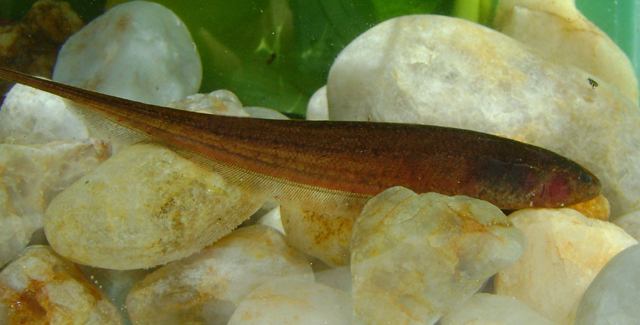| Hypopomidae (Bluntnose knifefishes) |
| 15.19 cm OT (male/unsexed) |
|
benthopelagic; freshwater |
| South America: Brazil, Uruguay and Paraguay. |
|
Anal soft rays: 155-198. Diagnosed from all congeners by the extreme broadening of the distal portion of the caudal filament in males during the reproductive period to form a distinct paddle shaped structure
(vs. moderately broadened distally in Brachyhypopomus pinnicaudatusand Brachyhypopomus brevirostris into paddle-shaped structures, and vs. broadened along most of the length of the caudal filament in Brachyhypopomus occidentalis, Brachyhypopomus diazi, Brachyhypopomus beebei, and Brachyhypopomus janeiroensis). Differs further from other species of the genus by the following characters: caudal filament length 17.3-35.2% of LEA; pectoral fin ray length 4.1-5.8% of LEA; body depth 8.8-12.2% of LEA; snout length 20.7- 30.0% of HL; gape width 9.5- 16.5% of HL; interorbital distance 22.7-35% of HL; branchial aperture 16.5-26% of HL; head width at operculum 48.4-65% of HL; head width at eyes 31.3-45.6% of HL; number of anal fin rays 155-198; upper jaw equal to lower jaw (Ref. 76853).
Description: A vii-xii,148-186; P i-ii,13-15 (Ref. 76853). |
| Occurs in river edges, slow-moving creeks, lagoons and flooded areas with muddy or sandy bottom and abundant emergent or floating vegetation (Ref. 76853). Length type refers to the length to the end of anal fin (LEA), measured as the distance from tip of snout to posterior end of anal fin base (Ref. 76853). |
|
Least Concern (LC); Date assessed: 01 September 2020 Ref. (130435)
|
| harmless |
Source and more info: www.fishbase.org. For personal, classroom, and other internal use only. Not for publication.

